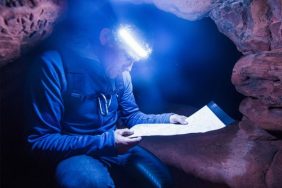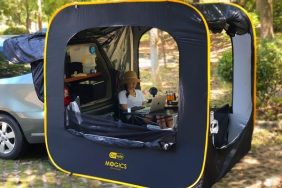Hopscotch, a “mobile opera” experience, feels like the tech-induced insanity that one imagines is life as a Silicon Valley mobile tech bro jacked up on a crazy amount of apps, chats, emails, and constant “ping” sounds, giving him no choice but to spiral into a tunnel of psychological disassociation and physical distancing from any human contact.
Created and produced by the LA-based company The Industry — not to be confused with the entertainment industry, which is often-times referred to as just “the industry” — Hopscotch takes audience members on a literal ride in many different limousines, on-foot through parks and warehouses and other places located on L.A.’s East Side. There are three different routes that make-up the one longer narrative story that is Hopscotch, but unless you have a lot of free time on your hands you’ll only journey on one of those three routes, which are color-coded as either green, red or yellow, together completing all the colors of a traffic light.
In addition to the driving around and getting in-and-out at various locations, The Industry adds another element to this fragmented experience: mobile phones. The performance is always either being video-taped live by smartphones positioned inside the cars, or by audience members who are given smartphones in order to record the scenes, many of which take place while moving on-foot.

This production fails for multiple reasons, the first being that it does not create any sense of community or connection amongst the audience members. We all met at a certain starting point, which we were only told about via an email which contained a nauseating amount of instructions and then, finally, a link that we had to click on in order to figure out where to start. Though we were told that we would be on a journey together with this small group of four people total, including myself, there were no introductions or any sort of “get to know you” type exercise that could have created a sense of connection. Instead, we were told that we — total strangers — would be traveling together in close confines, and that we absolutely should not use our phones to contact people or take photos. This premise is reminiscent of the strict rules of reality TV shows, which include not letting anyone become friends or even friendly beforehand; instead, people are thrown into a space together for a period of time with the hopes of creating chaos, conflict and drama that will help the narrative along. I attempted to interact, or even joke around, with the other reporters in my car once we started moving, but there wasn’t actually time for any real conversation.

The use of mobile technology throughout Hopscotch was supposed to be a selling point, an entry point for engaging with some of the questions that we have as a global hyper-connected mobile culture about the appropriateness of phones in relation to theater, performance, visual communication and social situations. Instead, the mobile phones added a secondary layer of uselessness, of unwarranted excess and overproduction. There were phones in the limos, positioned so that the actors would be recorded while singing. The audience members were given phones in places like parks and on rooftops, and asked to record the actors. We were given headphones at another stop in the tour/opera, and then were told to follow an actor around a public square/train station, but to listen to him through the headphones only. We were also told to never use our phones, and not to take photos of the performance. But when you’re on a journey with strangers through unfamiliar locations and into random vehicles, sometimes the only feeling of safety occurs when staring at your own phone. I felt like I had failed at participating in this performance when I took out my phone about 45 minutes in and started texting and tweeting and photographing the whole thing, but actually I wanted to feel a sense of connection with a person or people as a way to counteract the feelings of isolation and alienation I was experiencing through this production.

The non-chronological nature of this production’s storyline further solidified how uninteresting it truly is. On top of the chaotic nature of cars and phones and unnecessary surveillance techniques as “art,” the fact that we went from one scene to another but had no storyline to follow added to the building sense of isolation. It was STRONGLY SUGGESTED to me in ALL CAPS via email that I read the synopsis beforehand, which I did because I wanted to participate. Unfortunately, it added nothing but a convoluted storyline that sounded more Days of Our Lives than Orpheus and Euridice (which was an influence on this show).

There are performance companies in Los Angeles that both make use of abandoned space and handle movements between audiences and actors in ways that are graceful, inviting and inclusive. The Wilderness’ gorgeous production “The Day Shall Declare It” starring Annie Saunders and Nick Konow, which ran earlier this year in Downtown L.A., took place in an abandoned warehouse. Audience members wandered through with the performers and felt enveloped in the performance without experiencing a sense of disconnection. In that production, there was absolutely no need to pull out a smartphone in order to reach out and feel connected to somebody real who wasn’t physically there.
Hopscotch runs through November 15.
Photos by Alicia Eler.







